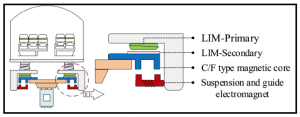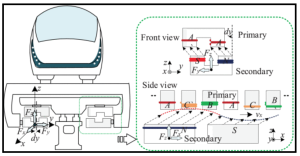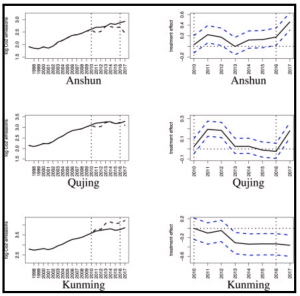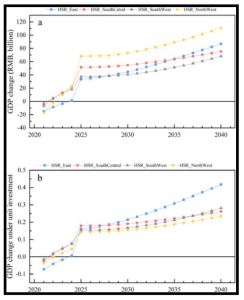Connection
How Canada Would Benefit from Maglev Trains
Ethan Drake
How Canada Would Benefit from Maglev Trains
by Ethan Drake
Abstract
Maglev trains are trains that work using the principle of magnetic attraction, where instead of using wheels to move along a rail, magnets levitate the train above the rail and propel it forward. This paper compares Maglev trains to automobiles, planes and alternative train types. Maglev trains are brought up in a Canadian context, looking at the social, environmental and economic benefits presented. Includes potential reasons as to why Canada hasn’t already developed Maglev trains as well as potential partnerships that could be made to implement them.
Introduction
Maglev trains and high-speed rail are being developed across the world as a form of transportation, with key countries being China, Japan, South Korea and Germany. These countries, to various levels, have emphasized the importance of fast transportation by implementing these systems domestically to increase economic growth, lower carbon emissions, and decrease economic and technological disparities. Maglev trains are a marvel of modern technology, and their development is a path to futures dreamed about for decades. With the implementation of maglev train infrastructure also comes the opportunity for urbanization and further development in all sectors. By implementing this technology in Canada, amenities will become more accessible, economic inequality will decrease, technological advancements will be at the forefront, and the country will be more united and accessible to the entire population. This paper acts as a brief introduction to what maglev trains are, how they work, and their benefits in a Canadian context. Additionally, this paper will briefly touch on potential reasons as to why development has yet to commence in Canada, and potential partnerships that could be made to implement maglev trains.
How Maglev Trains Work
As the development of urban centers has widely increased worldwide, countries such as Japan, China, Germany and South Korea have recognized the requirement and importance of fast and efficient transportation between different regions[1], [2]. Maglev trains help to fill this need by providing fast and efficient transportation along with low amounts of noise pollution. These trains differ from conventional wheel-rail high-speed trains as they are frictionless, only requiring three key principles to effectively function, namely propulsion, levitation and guidance, or PLG. One of the ways maglev trains are engineered to complete these PLG functions is by electromagnetic suspension or EMS [1], [3]. Existing EMS maglev trains typically use either linear induction motors (LIM) which are present in low to medium-speed trains or linear synchronous motors (LSM) which are present in high-speed trains [1]. In an LIM-based system, a primary motor is attached to the train while a secondary motor is attached to the track. Propulsion is achieved by the operation of LIM, while levitation and guidance are achieved by an electromagnetic system installed between the train and the track [1]. The structure of the LIM-based system is shown in Fig. 1.

(Fig. 1) LIM-based EMS maglev, suited for low to medium-speed travel [1].
In an LSM-based system, the primary motor is installed on the track, while the secondary motor is installed on the train. The propulsion and levitation forces are realized by the interaction between the onboard electric excitation secondary motor and long primary motor laid on track, while guidance forces are provided by electromagnets installed on the train [3]. The structure of the LSM-based system is shown in Fig. 2.

(Fig. 2) LSM-based EMS maglev, suited for high-speed travel[3].
One of the shortcomings of current maglev trains is the cost of producing the maglev rail required for the trains, accounting for 60-80% of the whole investment of the magnetic levitation train system [2]. At present, new developments in China have been focused on creating a system that can manage the PLG simultaneously to lower costs and streamline maintenance, called a Transverse Flux Linear Synchronous Motor or (TFLSM) [1], [3]. “TFLSM eliminates the expense of guiding induction panels along the track as well as onboard guiding electromagnets and guiding control systems.” [1]. The TFLSM system works by attaching the primary motor to the underside of the rail, and the secondary motor to the undercarriage of the train. The primary and secondary motors both adopt a U-shape to best produce a magnetic current [3]. The structure of the TFLSM-based system is shown in Fig. 3. At present, this system has not been used in any large-scale projects, as it is still in development.

(Fig. 3) TFLSM-based EMS maglev [3].
Comparison to Alternatives
Comparison to Automobiles
When comparing maglev trains to conventional automobiles, there are a few key aspects that should be noted, specifically speed, reliability, upkeep costs and versatility. Maglev trains can attain much higher speeds than any automobile, with the Shanghai Longyang Road airport line able to attain a speed of 600 km/h in China [1], with the average speed sitting around 300km/h. The fastest automobile, the Koenigsegg Jesko Absolut comes in at 530km/h [4], with the average speed limit in Canada at 100km/h [5]. On average, Canadians will need to bring their automobiles in for maintenance every 8000 to 12000 km, with maintenance costs annually around $1400-$1500 [6]. Maglev trains generally receive service every month to ensure everything is functioning to standard [7], and costs are almost exclusively funded by passengers. Each train on the Shanghai Longyang Road airport line can accommodate 959 passengers, with tickets ranging from $9.50-$20 when converted to Canadian dollars [8]. Most automobiles only have enough room for 4-6 passengers, with monthly gas costs sitting around $300 [9]. Automobiles are much more versatile when compared to trains, as they vary extensively when it comes to shape and size, with many having lifted suspensions to more effectively drive on rough terrain, while maglev trains are limited to the tracks available. If maglev trains were to be implemented in Canada, the role of automobiles would change significantly, rather than a catch-all transportation machine, they would be relegated to much more specific roles such as use in more rural areas, and in heavy industry, while maglev trains would take the place of general ground transport in urban population centers.
Comparison to Planes
When comparing maglev trains to planes, the main aspects to consider are speed, cost for individuals, and application. The fastest commercial plane is the Boeing 747, reaching speeds of up to 1130km/h, and the fastest maglev train is the Shanghai Longyang Road airport line able to attain a speed of 600 km/h in China [1], [10]. With current infrastructure, automobiles are becoming increasingly popular when compared to air travel due to the rise in airfares, with 45% of Canadians reporting that bus travel was much more affordable [11]. With maglev infrastructure, air travel will likely wane much more; maglev trains come much closer to the top speeds of planes compared to buses, while also keeping prices per ride low, with tickets for the Shanghai Longyang Road airport line ranging from $9.50-$20 when converted to Canadian dollars [8]. If Canada were to adopt maglev infrastructure, planes would still have an important role, namely allowing for safe and efficient transportation between oceans, while maglev trains would become the primary transport throughout the country.
Comparison to Alternative Train Types
When comparing maglev trains to alternative train types, the main factors to consider are speed, application, and maintenance costs. At present there is a proposed high-speed rail project that will connect Toronto to Montreal being discussed provincially and federally [12]. The proposed project would have projected speeds up to 300km/h [13]. This is a great development plan for Canadian infrastructure, with many projecting that this will stimulate the economy and help put into perspective the positive change that would come from the development of maglev train systems throughout Canada [14]. The Shanghai Longyang Road airport line can attain a speed of 600 km/h in China [1], much faster than the proposed high-speed rail. One reason for this relates to their key difference, as maglev trains are frictionless while high-speed trains require wheels on the track, creating friction, and limiting the speed of the system. Maglev trains offer less expensive operating and maintenance costs when compared to high-speed rail trains while also offering higher speeds, more comfortable riding environments and low noise [1], [3], [15]. Maglev trains can be developed with lower speed options in mind, better for urban environments with more stops, or higher speeds for longer distances. If maglev trains were to be implemented in Canada, slower-style trains would be relegated to use in hauling freight as maglev trains are not currently optimized for that task; maglev trains would have primary usage as general ground transport for the population.
Maglev Trains in a Canadian Context
Social Benefits
Maglev trains would revolutionize transportation, as with enough investment into their infrastructure, Canadians would be able to get across the country in a matter of hours instead of days. Having Canadian society become more connected would more easily allow Canadians to seek work anywhere in the country, as with the current infrastructure there is a steep monetary barrier to movement within Canada, preventing less-fortunate Canadians from exercising their Mobility Rights as laid out in the Charter of Rights and Freedoms [16]. Connecting the nation via maglev trains would more easily allow for the urbanization of the country; currently, there are stark differences between the more urbanized parts of the country and the more rural parts, with rural areas sometimes not even having acceptable access to healthcare, internet, and in some cases, running water [17]. Maglev Trains would be a first step in connecting the country and giving every Canadian equal access to amenities. Maglev trains are also much safer when compared to conventional automobile transport, whereas the last major maglev incident occurred in 2006, with 23 fatalities, and 11 total injuries, in Canada, in 2021 there were 1,768 motor vehicle fatalities, and 108,018 total motor vehicle injuries [18].
The recent discussions around implementing high-speed rail between Toronto and Montreal are important in acknowledging the need for better infrastructure in Canada. The greater Toronto area and Montreal metropolitan area account for approximately 10 million Canadians, with Toronto and Montreal being the first and second largest cities in the country, with roughly 27% of the population living in or near these cities [19]. These cities also house many university students; (totalling the student populations from McGill University [20], Université de Montréal [21], Concordia University [20], Université du Québec à Montréal [23], School of Higher Technology – University of Quebec [24], OCAD University [25], University of Toronto [26] and Toronto Metropolitan University [27] there are over 300,000 university students within the area where development is being proposed. Having reliable transport throughout large cities is essential for improving the quality of life of students, lower-income families, people with disabilities and commuters. These improvements would affect many more people if maglev infrastructure were implemented throughout Canada, creating more time for leisure, work, and community development.
With maglev infrastructure built throughout the country, urban planning would become significantly easier, creating opportunities for integrating environmental friendliness, social inclusion, innovation-driven economics and smart urban governance.
Environmental Benefits
As maglev trains are powered by electromagnetism, they do not emit carbon dioxide and are a green form of transportation [28]. In our current infrastructure, automobiles are a primary source of transportation, with planes being used for longer distances. The average car emits approximately 4600kg of CO2 every year, with approximately 26 million vehicles in use [29], [30]. “Canadian air operators released approximately 22 megatons (Mt) of carbon dioxide equivalent (CO2e) emissions in 2019, from both domestic and international operations; this is roughly equivalent to the GHG emissions generated from driving 4.8 million cars for a year.” [31]. As both of these transportation sources produce heavy emissions, maglev trains would be a large step in the direction of carbon neutrality in the transportation industry, as the reliance on automobiles and planes would decrease significantly with enough investment into its infrastructure.
During the development of maglev and high-speed rail in China, increases in emissions were found and projected. These emissions have increased during the construction and development stages, primarily due to the energy consumption of equipment and materials such as steel and concrete [32].
Li et al. note:
(1) high-speed rail can significantly improve urban carbon emission efficiency and that this conclusion is still valid after alleviating the endogenous problem and carrying out a number of robustness tests. (2) The heterogeneity study finds that the improvement effect of high-speed rail on urban carbon emission efficiency is more significant in non-resource-based cities and large cities. (3) The analysis of the mechanism shows that high-speed rail can improve urban carbon emission efficiency by promoting technological innovation, strengthening environmental regulations, improving industrial structure and weakening market segmentation. [32].
After an analysis of the study by [32], [33] it has been projected that during the development of maglev and high-speed rail, emissions increase due to the increased use of fossil fuel-based transport, as well as energy consumption from equipment and heavy materials such as steel, iron and concrete. Once finished, high-speed rail helps significantly in lowering carbon emissions in cities that do not rely on heavy industry, and moderately decreasing carbon emissions in cities that do rely on heavy industry [32], [33]. Some recommendations from [30] include an emphasis on accelerating the development of high-speed rail throughout the country to connect the nation, enhancing development in technologies aided by the new rail system, and absorbing knowledge and technology from developed regions.
The results from [33] show the projected carbon emissions during the given year and show the effect that the completed high-speed rail infrastructure had on emission intensity.
Canada can and should learn from these reports, as developing a maglev transportation system would help our country lower emissions in the long run, and provide ample opportunities for scientific development throughout the process.

(Fig. 4) Estimated treatment effect of HSR station on Chang–Kun segment.
Notes: Solid lines are actual series of log CO2 emissions and dashed lines are predicted counterfactual CO2 emissions. The two vertical lines denote the cut-off point T 1+1 when HSR projects started construction and the year when they started to operate, respectively. 3/6 stations shown [33].
Economic Benefits
Although there would no doubt be a steep cost for the development of infrastructure to support maglev trains, this cost would be offset by the savings on gas for vehicles and plane tickets by everyday Canadians. With about $1510 per person per year spent on gas for vehicles, and approximately 26 million vehicles in use, an estimated $39.2 billion is being spent by Canadians to use their vehicles [29], [30]. The average plane ticket in 2019 cost $239.30, with 162.8 million passengers that year, an estimated $38.9 billion was spent on plane tickets [34]. These numbers don’t account for vehicle upkeep costs, vehicle repairs, or luggage costs, and there is already an estimated $78 billion being spent by Canadians annually on transportation that produces heavy emissions. With the infrastructure to support maglev trains, there is no doubt these costs will go down as Canadians switch to greener transportation. A study was conducted in Massachusetts that found that nearly $64.1 Billion was being spent annually to uphold a car-centric infrastructure, with more than half coming from public funds[35]. Taking this data along with the population of Massachusetts being 6.985 million people [36], it can be calculated that each person was spending approximately $9176.80 to uphold this infrastructure. To compare this to a Canadian example, the population in Ontario is 15.6 million people [37], and if each person was paying the same amount as in the Harvard study, that would amount to $143.2 Billion being spent to uphold a car-centric infrastructure each year. This number would include gas, car maintenance, road maintenance, labour costs, costs of developing land for parking lots, etc. This rough estimate is only a snapshot of the total cost to Canadians that a car-centric infrastructure currently poses.
Throughout the development of maglev and high-speed rail in China, the Chinese community has kept a close eye on both their economy and the disparities throughout the country and has noted the positive effects of development.
Yang et al. note that:
“Economists have highlighted the importance of the high-speed rail (HSR) network in China to economic development. They have noted that in the HSR era, the distance is no longer the physical length between points but is measured according to the travel time. Based on an evaluation of traffic cost savings, it has been concluded that HSR construction improves the accessibility level and gross domestic product (GDP) of the cities along the lines (Li et al., 2018; Liu and Wang, 2017).” [38].

(Fig. 5) (a) the annual changes in GDP (RMB, billion) and (b) the annual GDP changes per unit investment cost under different scenarios compared to the baseline (i.e., no HSR construction). Colours indicate different scenarios, including HSR_East (high-speed rail investment in eastern China), HSR_SouthCentral (high-speed rail investment in South-central China), HSR_SouthWest (high-speed rail investment in Southwest China), and HSR_NorthWest (high-speed rail investment in Northwest China). [38].
The above graphs in Fig. 5 illustrate the economic effects of high-speed rail infrastructure in China. Decreasing disparities between different regions, bringing technological advancements to regions that previously did not have the capabilities, increasing the efficiency of allocation of resources, and promoting growth in all industries.
Canada would benefit significantly by adopting maglev and high-speed rail infrastructure throughout the nation, helping to decrease the disparity between provinces, increasing the efficiency of travel, allocation of resources, and bringing to the forefront national collaboration.
Why Aren’t Maglev Trains Already In Canada?
Political Discussion
One of the potential reasons why maglev and high-speed rail infrastructure is not widely in development throughout Canada is likely due to lobbying by industries that would stand to benefit from preventing their development. The Oil Lobby, Automotive Industry Lobby and Airplane Lobby would all lose out on large pieces of the market if maglev trains and high-speed rail were in wide usage throughout Canada, as automobiles would be in use much less, as would fossil fuels, and planes would be needed much less. These lobbies are all quite large and have a lot of sway in both the Canadian political system as well as the American political system. During this year’s UN Climate Summit, a record number of fossil fuel lobbyists were present, with the main goal of undermining talks about climate change and lowering emissions [39]. It will always be difficult to enact positive change when profit is the primary concern. Canadians need to understand the control these groups have over the government and work toward enacting change to save our planet and our species.
Potential Partnerships
One of the potential partnerships that could be made to develop maglev and high-speed rail in Canada would be with China. China has been at the forefront of the development of high-speed rail and maglev trains, with their Shanghai Longyang Road airport line able to attain a speed of 600 km/h [1]. This partnership would also be a road toward a more positive relationship with China. In Canada, the Trudeau government has been steadily attempting to improve relations with China, though increasing tensions between the United States and China have slowed the improvement of relations significantly [40]. An agreement around maglev and high-speed rail development would be economically beneficial for both parties and would be a great way to build a lasting relationship between China and Canada.
Canada could also partner with Japan in developing maglev and high-speed rail throughout the country, with Japan and Canada already having a positive relationship, as well as a positive trade relationship [41]. Japan currently has the record for the fastest maglev train in the world, with their L0 Series SCMaglev able to attain speeds of up to 603km/h [42]. A deal regarding the future development of maglev trains and high-speed rail in Canada would benefit both countries economically, and potentially pave the way for more infrastructure deals between the two nations.
Conclusion
After analyzing the benefits presented by maglev infrastructure being adopted in Canada, it is clear that the nation will benefit from economic growth through efficiency of resource allocation, further advancement of technology in all fields and further urbanization. Maglev trains, along with high-speed rail, are technologies that will lead Canada on the road to success, cementing a large first step in creating a net-zero economy, and bringing to the forefront technological advancements. Canada has many potential partners for the development of maglev infrastructure, and regardless of whether Canada decides to look for assistance in development or complete development domestically, development must commence. The future is now, we have only to build it, and provide a better tomorrow for our communities, our nation, and the world.
References
[1] G. Lv, L. Cui, R. Zhi, and Z. Zhang, “Characteristic Analysis of Improved Transverse Flux Linear Synchronous Motor Integrated Propulsion, Levitation and Guidance for Maglev Train,” IEEE Trans. Veh. Technol., vol. 72, no. 9, pp. 11428–11436, Sep. 2023, doi: 10.1109/TVT.2023.3265844.
[2] F. Guo, Y. Tang, L. Ren, and J. Li, “Structural parameter optimization design for Halbach permanent maglev rail,” Phys. C Supercond. Its Appl., vol. 470, no. 20, pp. 1787–1790, Nov. 2010, doi: 10.1016/j.physc.2010.05.207.
[3] G. Lv, L. Cui, R. Zhi, T. Zhou, and Y. Liu, “Investigation of the Transverse Flux Linear Synchronous Motor Integrated With Propulsion, Levitation and Guidance for the Maglev Train,” IEEE Trans. Transp. Electrification, vol. 9, no. 3, pp. 4113–4120, Sep. 2023, doi: 10.1109/TTE.2023.3246070.
[4] “World’s Fastest Production Cars,” J.D. Power. Accessed: Dec. 08, 2023. [Online]. Available: https://www.jdpower.com/cars/shopping-guides/worlds-fastest-production-cars
[5] “Speed Limits – U.S. and Canada | ezbordercrossing.” Accessed: Dec. 08, 2023. [Online]. Available: https://www.ezbordercrossing.com/travel-resources/speed-limits-u-s-and-canada/
[6] “How to Calculate your Annual Car Maintenance Budget.” Accessed: Dec. 08, 2023. [Online]. Available: https://www.canadadrives.ca/blog/maintenance/setting-your-annual-car-maintenance-budget
[7] L. K. Siu, D. Chan, T. Mellor, and D. Carden, “An operation and maintenance perspective of low speed Maglev applications,” Comput. Railw. VIII.
[8] “Everything about Shanghai Maglev Train: Speed, Station, Map, Ticket & Price, Facts…” Accessed: Dec. 08, 2023. [Online]. Available: https://www.chinadiscovery.com/shanghai/shanghai-maglev.html
[9] “What Is the Total Cost of Ownership for a Car? | Ratehub.ca.” Accessed: Dec. 08, 2023. [Online]. Available: https://www.ratehub.ca/blog/what-is-the-total-cost-of-owning-a-car/
[10] T. Rains, “The fastest private jets in the world ranked by speed,” Business Insider. Accessed: Dec. 08, 2023. [Online]. Available: https://www.businessinsider.com/worlds-fastest-private-jets-rocket-at-over-700-mph-list-2023-10
[11] “Canadian travellers would rather drive than fly: Report,” torontosun. Accessed: Dec. 08, 2023. [Online]. Available: https://torontosun.com/news/national/canadian-travellers-would-rather-drive-than-fly-report
[12] K. D. C. N. T. M.-P. W. F. | Contact, “The Toronto to Montreal high-speed train just got another step closer,” Toronto. Accessed: Dec. 07, 2023. [Online]. Available: https://toronto.ctvnews.ca/the-toronto-to-montreal-high-speed-train-just-got-another-step-closer-1.6337371
[13] C. R. · T. C. Press ·, “Feds slow down timeline for faster Toronto-Quebec City railway | CBC News,” CBC. Accessed: Dec. 07, 2023. [Online]. Available: https://www.cbc.ca/news/canada/montreal/via-rail-toronto-quebec-city-consortia-1.6912715
[14] S. Zeitchik, “All this money pouring into infrastructure should be a boon for high-speed rail, right? Not so fast.,” Washington Post, Nov. 19, 2021. Accessed: Dec. 07, 2023. [Online]. Available: https://www.washingtonpost.com/technology/2021/11/18/infrastructure-bill-high-speed-rail/
[15] “Economics – Maglev.” Accessed: Dec. 08, 2023. [Online]. Available: https://www.maglevboard.net/en/facts/10-economics
[16] D. of J. Government of Canada, “The rights and freedoms the Charter protects – Canada’s Sytem of Justice.” Accessed: Dec. 07, 2023. [Online]. Available: https://www.justice.gc.ca/eng/csj-sjc/rfc-dlc/ccrf-ccdl/rfcp-cdlp.html
[17] G. of C. I. S. Canada, “Map of long-term drinking water advisories on public systems on reserves.” Accessed: Dec. 07, 2023. [Online]. Available: https://www.sac-isc.gc.ca/eng/1620925418298/1620925434679
[18] T. Canada, “Canadian Motor Vehicle Traffic Collision Statistics: 2021,” Transport Canada. Accessed: Dec. 08, 2023. [Online]. Available: https://tc.canada.ca/en/road-transportation/statistics-data/canadian-motor-vehicle-traffic-collision-statistics-2021
[19] S. C. Government of Canada, “Census of Population.” Accessed: Dec. 08, 2023. [Online]. Available: https://www12.statcan.gc.ca/census-recensement/index-eng.cfm
[20] “2022 Quick Facts,” About McGill. Accessed: Dec. 08, 2023. [Online]. Available: https://www.mcgill.ca/about/quickfacts
[21] “In figures,” Université de Montréal. Accessed: Dec. 08, 2023. [Online]. Available: https://www.umontreal.ca/en/udem/in-figures/
[22] “Fast facts – Concordia University.” Accessed: Dec. 08, 2023. [Online]. Available: https://www.concordia.ca/content/concordia/en/about/fast-facts.html
[23] “About UQAM – UQAM,” Université du Québec à Montréal. Accessed: Dec. 08, 2023. [Online]. Available: https://uqam.ca/en/information/about/
[24] “School of Higher Technology – University of Quebec 2023 Ranking & Review | uniRank.” Accessed: Dec. 08, 2023. [Online]. Available: https://www.4icu.org/reviews/universities-english/568.html
[25] “Facts and figures.” Accessed: Dec. 08, 2023. [Online]. Available: https://www.ocadu.ca/about/facts-and-figures
[26] “Quick facts | University of Toronto.” Accessed: Dec. 08, 2023. [Online]. Available: https://www.utoronto.ca/about-u-of-t/quick-facts
[27] “UndergraduateStudents_AllYears2020-21.pdf.” Accessed: Dec. 08, 2023. [Online]. Available: https://www.torontomu.ca/content/dam/university-planning/Data-Statistics/Key-Statistics/2020-21/AllYears/UndergraduateStudents_AllYears2020-21.pdf
[28] S. Inoue and Y. Fujimoto, “PM Magnetic Levitation Train Using Hybrid Electromagnetic- and Electrodynamic-Suspension System,” in 2022 International Power Electronics Conference (IPEC-Himeji 2022-ECCE Asia), May 2022, pp. 415–421. doi: 10.23919/IPEC-Himeji2022-ECCE53331.2022.9806950.
[29] “Automotive Industry Statistics in Canada,” Made in CA. Accessed: Dec. 07, 2023. [Online]. Available: https://madeinca.ca/automotive-industry-statistics-canada/
[30] “How much do Canadians spend on gas? – Manitoba Electric Vehicle Association.” Accessed: Dec. 07, 2023. [Online]. Available: https://manitobaev.ca/ev-news/how-much-do-canadians-spend-on-gas/
[31] “CANADAs-AVIATION-CLIMATE-ACTION-PLAN-2022-2030.pdf.” Accessed: Dec. 07, 2023. [Online]. Available: https://www.icao.int/environmental-protection/Documents/ActionPlan/CANADAs-AVIATION-CLIMATE-ACTION-PLAN-2022-2030.pdf
[32] X. Li and Z. Cheng, “Does high-speed rail improve urban carbon emission efficiency in China?,” Socioecon. Plann. Sci., vol. 84, p. 101308, Dec. 2022, doi: 10.1016/j.seps.2022.101308.
[33] Z. Yan and S. Y. Park, “Does high-speed rail reduce local CO2 emissions in China? A counterfactual approach,” Energy Policy, vol. 173, p. 113371, Feb. 2023, doi: 10.1016/j.enpol.2022.113371.
[34] S. C. Government of Canada, “Domestic and international average air fares, by fare type group, quarterly.” Accessed: Dec. 07, 2023. [Online]. Available: https://www150.statcan.gc.ca/t1/tbl1/en/tv.action?pid=2310003601
[35] L. Parsons, “Massachusetts’ car economy costs $64 billion, study finds,” Harvard Gazette. Accessed: Dec. 08, 2023. [Online]. Available: https://news.harvard.edu/gazette/story/2020/01/massachusetts-car-economy-costs-64-billion-study-finds/
[36] “Massachusetts – Place Explorer – Data Commons.” Accessed: Dec. 08, 2023. [Online]. Available: https://datacommons.org/place/geoId/25/?utm_medium=explore&mprop=count&popt=Person&hl=en
[37] S. C. Government of Canada, “Population estimates, quarterly.” Accessed: Dec. 08, 2023. [Online]. Available: https://www150.statcan.gc.ca/t1/tbl1/en/tv.action?pid=1710000901
[38] Q. Yang et al., “The impact of China’s high-speed rail investment on regional economy and air pollution emissions,” J. Environ. Sci., vol. 131, pp. 26–36, Sep. 2023, doi: 10.1016/j.jes.2022.07.020.
[39] “Record number of fossil fuel lobbyists at COP undermines critical climate talks,” Amnesty International. Accessed: Dec. 08, 2023. [Online]. Available: https://www.amnesty.org/en/latest/news/2023/12/global-record-number-of-fossil-fuel-lobbyists-at-cop-undermines-critical-climate-talks/
[40] “Is China’s Xi Jinping a dictator? How Trudeau answered at APEC – National | Globalnews.ca,” Global News. Accessed: Dec. 08, 2023. [Online]. Available: https://globalnews.ca/news/10098548/trudeau-apec-summit-presser/
[41] G. A. Canada, “Canada-Japan relations,” GAC. Accessed: Dec. 08, 2023. [Online]. Available: https://www.international.gc.ca/country-pays/japan-japon/relations.aspx?lang=eng
[42] “Shinkansen: Japanese Bullet and Maglev Trains,” JRPass.com. Accessed: Dec. 08, 2023. [Online]. Available: https://www.jrpass.com/blog/shinkansen-japanese-bullet-and-maglev-trains
